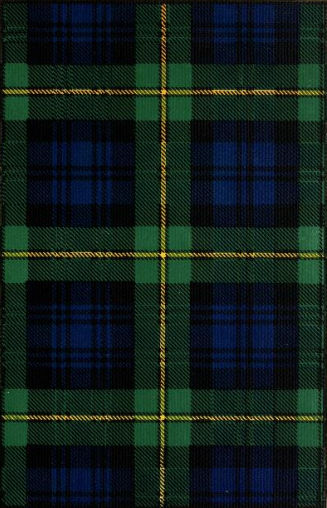Note: This article has been excerpted from a larger work in the public domain and shared here due to its historical value. It may contain outdated ideas and language that do not reflect TOTA’s opinions and beliefs.
From The Scottish Clans and Their Tartans: With Notes, 1900.
War Cry:—"A Gordon! A Gordon!"
Clan Pipe Music:—Salute—"Failte nan Gordonach" ("The Gordon's Salute"). March—"Spaidsearachd nan Gordonach" ("The Gordon's March").
Badge: ladh-shlat, Eitheann (Ivy).
The first Gordon of whom there is any distinct trace is Richard of Gordon, said to be the grandson of a famous knight who slew some monstrous animal in the Merse in the time of Malcolm III.
That Richard was Lord of the Barony of Gordon in the Merse is undoubted as between 1150 and 1160 he granted from that estate a piece of land to Monks of St. Mary at Kelso, a grant confirmed by his son Thomas. Other Gordons figure in history about this time, apart from Bertram de Gordon, whose arrow in 1199 wounded Richard of England at Chalons.
Alicia IV. of the Gordon family, an heiress, married her cousin, Adam Gordon, who was a soldier among the 1000 auxiliaries whom Alexander III. sent with Louis of France to Palestine, where he was slain. From his grandson, Sir Adam, all the Gordons in Scotland are descended, says Douglas; and the first appearance he makes in history was the assistance he gave Wallace in 1297 to recapture the Castle of Wigton, of which he was made Governor. For his many faithful services, Robert I., on the forfeiture of David, Earl of Athole, gave him a charter of the lands of Strathbogie (or Huntly). He was killed at Halidon Hill; but his son, Sir Alexander, escaped the slaughter, and was the first designed of Huntly.
Sir Adam Gordon, in descent tenth of Gordon and Huntly, whose father was slain at Otterburn lost his life fighting for his country at the battle of Homildon in 1402, leaving only a daughter, who married a second son of Seton of that Ilk. Their eldest son, Alexander, assumed the name of Gordon, and, in consequence of his great public services to James I. and James II., he was in 1445 created by the latter Earl of Huntly, and died some twenty years after at a very great age.
To trace all the great actions and deeds of the warlike line of Huntly would far exceed our space. Alexander, third Earl, fought at Flodden; George, fourth Earl, was General of the forces on the Borders to oppose those of Henry VIII. under Norfolk, with whom he had many victorious encounters; but in an attempt to get the Queen out of the hands of the Earl of Moray, he was attacked by the MacKenzies, Munroes, Frasers, and Macintoshes at Corrichie, where he was slain in 1562.
George, sixth Earl of Huntly, whose father had been High Chancellor, with other Catholic nobles, was suspected of having a secret correspondence with the Spaniards, and troops were sent against them by James VI. in 1594. The latter were defeated, but Huntly was pardoned, appointed Lieutenant of the North, and created a Marquis in 1599.
George, the second Marquis, was Captain of the Scottish Guard of Louis XIII., and was so strongly attached to the cause of Charles I., that he was forfeited by the Scottish Parliament in 1645, and his property seized. He lost his head for his loyalty at Edinburgh in 1049. Four years before this his eldest son perished in the Royal cause at the battle of Alford. George, fourth Marquis, was created a Duke, 1684, and his noble defence of the Castle of Edinburgh for James VII. is a stirring event in Scottish history.
On the death of George, fifth Duke, in 1836, the title became extinct, but the Marquisate of Huntly went to the Earl of Aboyne, lineally descended from Charles, fourth son of George, second Marquis of Huntly, who was raised to the Peerage of Aboyne by Charles 11. for his many loyal services.
The fighting force of the clan, when in arms for King James in 1715, is given by General Wade at 1000 claymores.
The Earls of Aberdeen, so created in 1682, are descended from Patrick Gordon of Methlic (cousin of the Earl of Huntly), who fell at the battle of Arbroath in 1445. They were afterwards designed as the Lairds of Methlic and Haddo.
Ten gentlemen of this clan were created Baronets, viz., Gordon of Gordonstoun, Gordon of Cluny, and Gordon of Lismore in 1625; Gordon of Lochinvar, 1626; Gordon of Park, 1686; Gordon of Dalpholly, 1704; Gordon of Earlstoun, 1706; Gordon of Embo, 1631; Gordon of Halkin (by succession), 1813; Gordon of Niton, 1818.
Two regiments, named the "Gordon Highlanders," have been raised from this clan. The first of these was the old "81st," formed in 1777 by Hon. Colonel William Gordon, son of the Earl of Aberdeen, and disbanded in 1783. The second was the "92nd," or Gordon Highlanders," raised by the Marquis of Huntly in 1794 memorable for its high valour in every war since then. When the system of linked battalions was instituted, the old 75th and 92nd became the Gordon Highlanders, and it is the former who are the heroes of Dargai.
The Scottish Clans and Their Tartans: With Notes. W. & A. K. Johnston, 1900.
About TOTA
TOTA.world provides cultural information and sharing across the world to help you explore your Family’s Cultural History and create deep connections with the lives and cultures of your ancestors.


